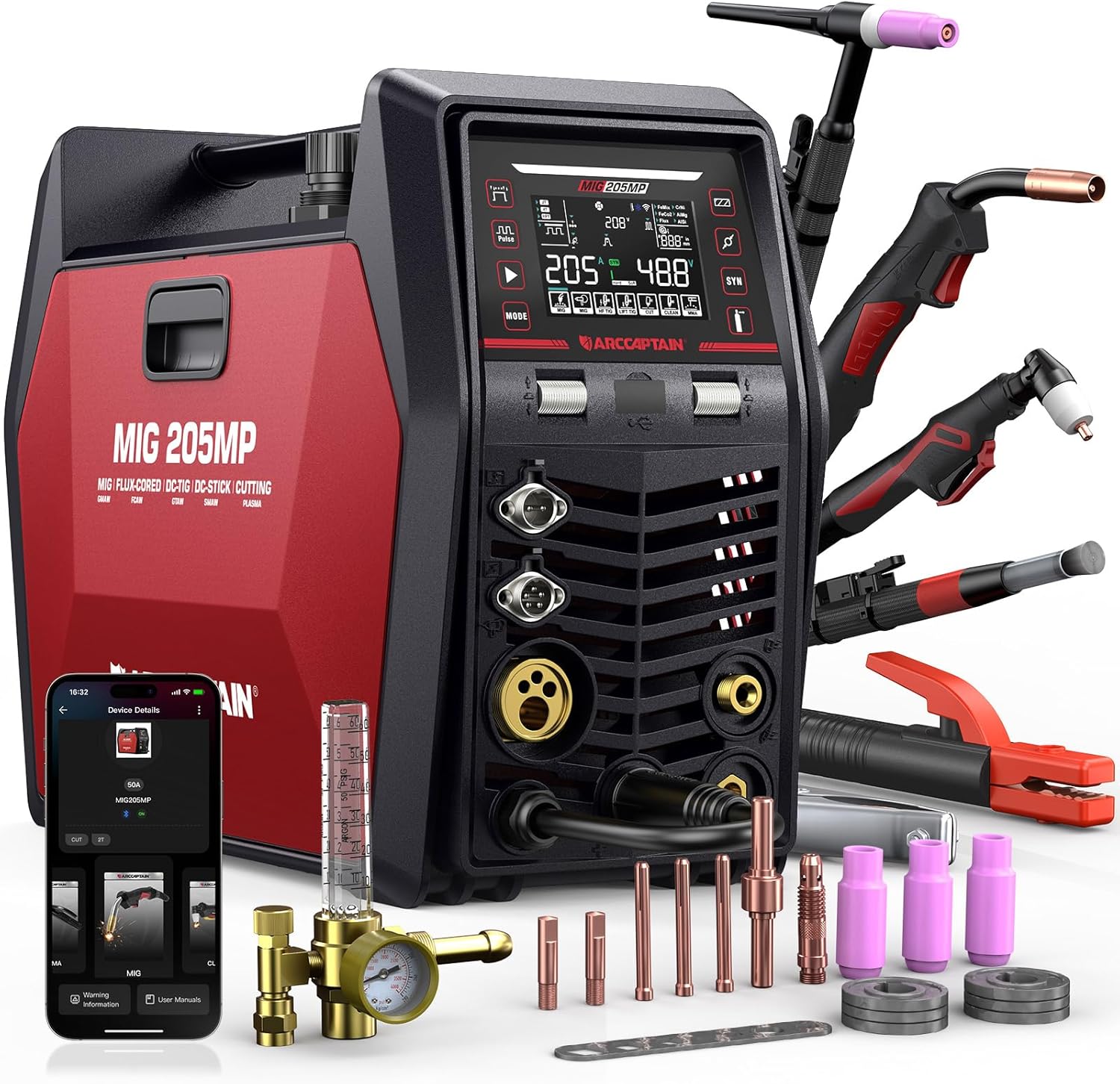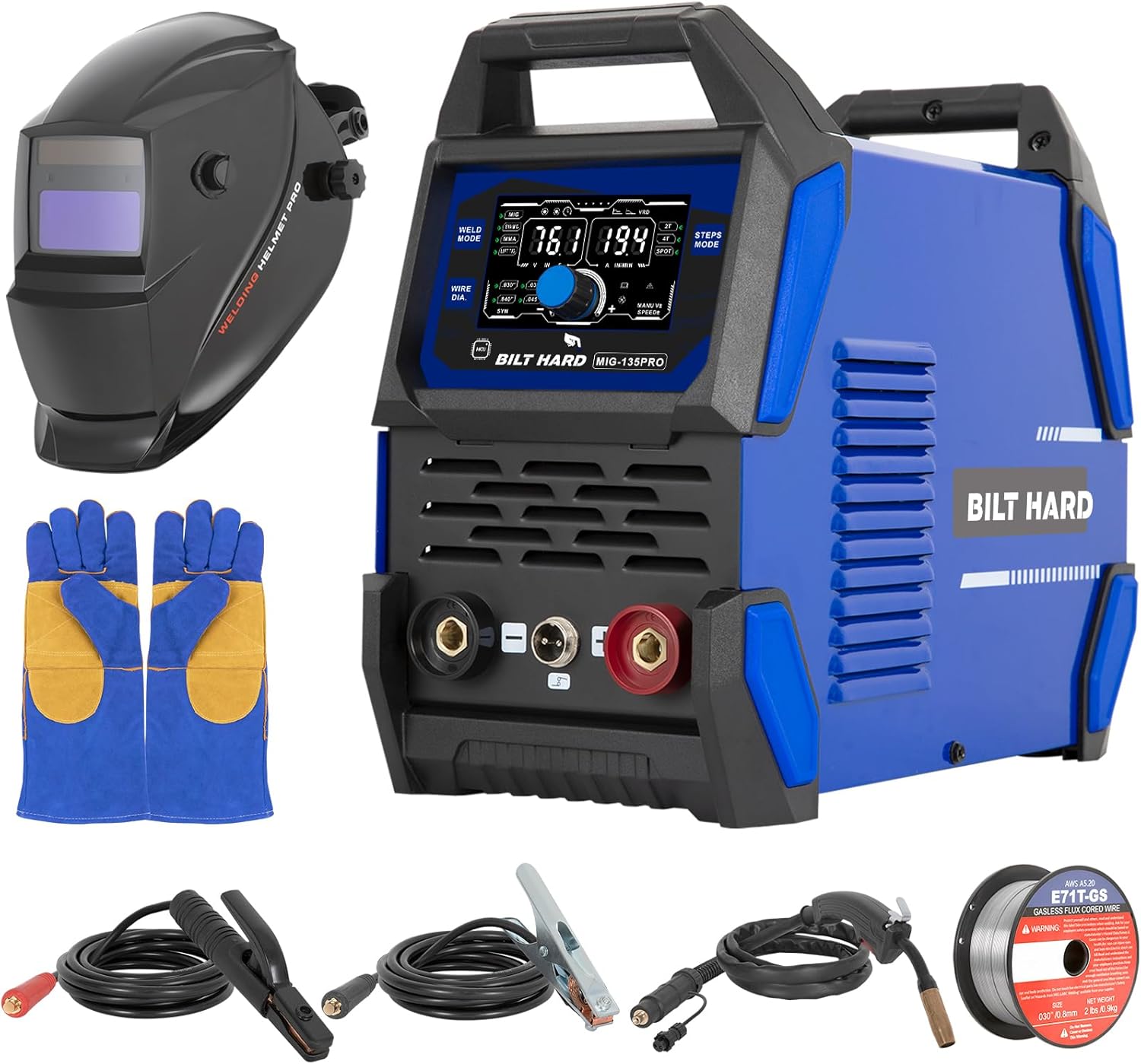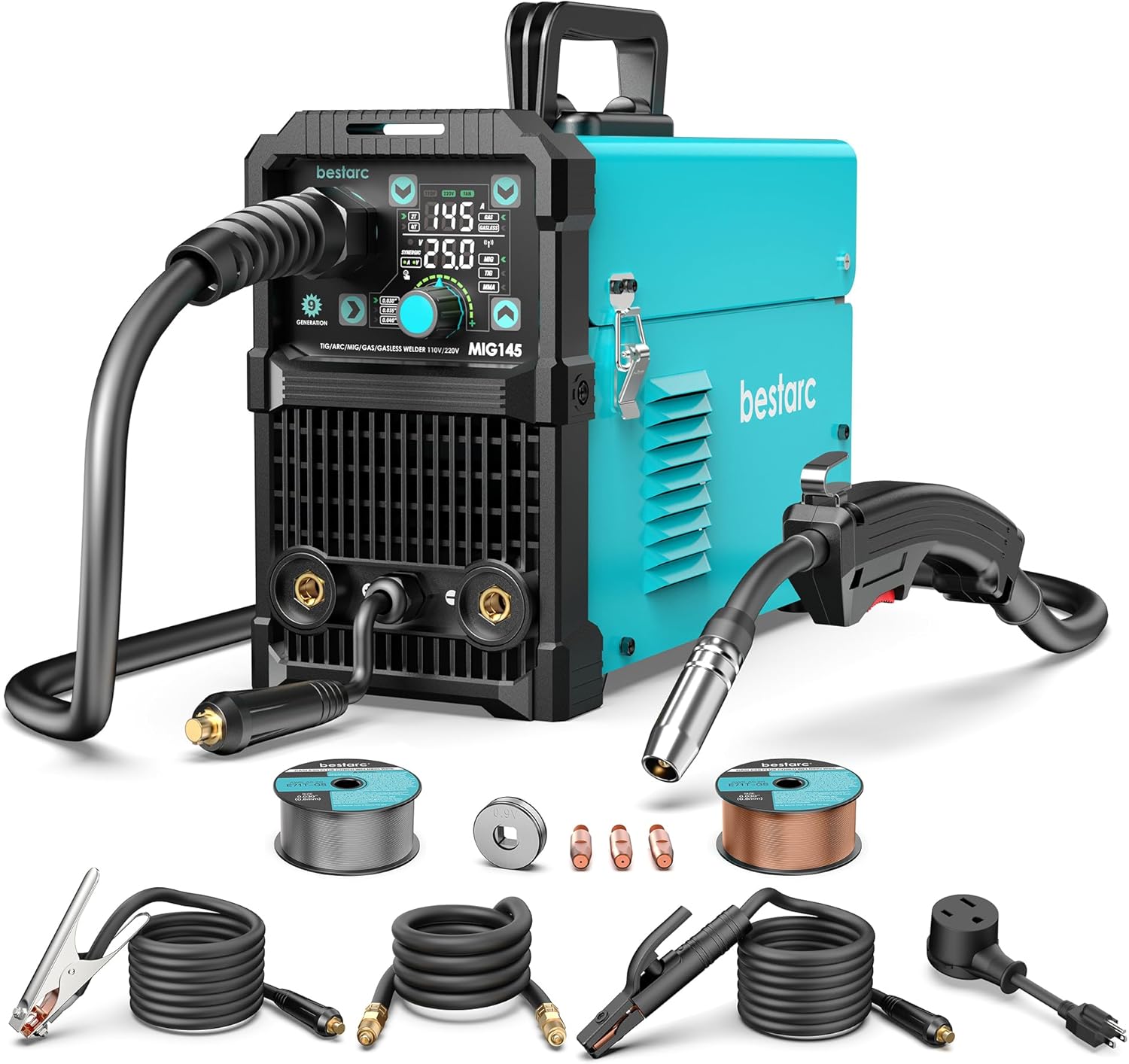Searching for the Best Welding Machines that deliver professional-grade performance across multiple welding processes without breaking the budget? Welders and fabricators understand the challenge of finding versatile equipment that handles everything from delicate TIG work to heavy-duty stick welding with consistent reliability. Modern multi-process welding machines have revolutionized metalworking by combining advanced inverter technology with intelligent control systems that automatically optimize parameters for different materials and applications. These sophisticated tools eliminate the need for multiple specialized machines while providing the precision and power required for both hobby projects and professional fabrication work. Ready to discover welding machines that blend cutting-edge technology with user-friendly operation for superior metal joining results? Let’s explore these exceptional tools that make professional-quality welding accessible to every skill level.
Contents
5. Arccaptain MIG 205MP

Revolutionary versatility defines this comprehensive welding system through nine distinct welding modes: Gas MIG, Gasless MIG, Cut, DC HF TIG, DC Lift TIG, MMA Stick, Clean, Spot Welding, and Spool Gun Aluminum Welding capabilities. This multiprocess approach perfectly handles diverse applications from home DIY projects and garage repairs to outdoor maintenance, farm equipment servicing, and professional road maintenance operations. The extensive mode selection eliminates the need for multiple specialized machines while providing professional-grade results across all applications.
Advanced technology integration features flagship 2025 design with revolutionary APP control functionality that enables parameter adjustment, real-time monitoring, and status detection within a 10-meter range. The unlimited preset memory system allows users to save and name custom settings through the mobile application, while the integrated FAQ section provides instant access to troubleshooting guides and solutions from the manufacturer’s knowledge base. This smart connectivity transforms traditional welding into a data-driven, optimized process.
Intelligent operation incorporates a large LED display for clear visibility of welding parameters and settings, ensuring intuitive operation across all skill levels. The smart parameter-matching system automatically adjusts current and voltage based on selected metal types and electrode sizes, making the machine beginner-friendly while significantly improving work efficiency. Advanced users benefit from detailed parameter control including MIG inductance and burn-back settings, DC TIG pulse frequency adjustments, and MMA hot start and arc force customization.
High-performance specifications include a 60% rated duty cycle with welding currents of MIG 30-205A, DC TIG/MMA 20-205A, Clean 20-40A, and Cut 20-50A capabilities. The cutting capacity reaches quality 12mm (1/2 inch) with maximum 18mm (2/3 inch) thickness handling. Dual-voltage design (120V/240V) provides flexible power switching, while compatibility with both DC Lift TIG and DC HF TIG torches plus foot pedal support enhances operational control and cost effectiveness.
4. Bilt Hard WLD-1606

Comprehensive functionality showcases through the 135-amp multi-process design offering three welding modes: Flux Core MIG, Lift TIG, and Stick welding capabilities. The system supports 2T/4T/Spot trigger modes that adapt seamlessly to quick repairs, extended seam welding, or precision spot welding applications. This versatile approach ensures high-quality, reliable results across diverse manufacturing processes while accommodating various project requirements from automotive work to general fabrication tasks.
Intelligent control technology features an LED digital display system that tracks real-time voltage, current, and wire speed through intuitive knobs and buttons. Specialized MIG mode controls include burn-back and inductance adjustments, while MMA mode offers hot start, arc force, and VRD (Voltage Reduction Device) customization. The IGBT inverter design significantly improves efficiency on standard 110V outlets, delivering continuous performance for garage applications, rooftop projects, farm work, and off-grid welding requirements.
User-friendly operation incorporates a synergic control system that automatically adjusts voltage and feed speed based on selected amperage settings. This intelligent parameter matching makes the machine an excellent choice for beginners and DIY enthusiasts who need consistent results without extensive welding experience. The automated adjustments eliminate guesswork while ensuring optimal welding parameters for different materials and applications.
Safety innovation includes comprehensive protection systems with automatic shutdown capabilities featuring error code display (E1 for overcurrent, E2 for overheat conditions) shown on the LED screen. The cooling fan continues operation for 1-2 minutes after shutdown, ensuring safe restart procedures and protecting internal components from thermal damage. The complete kit includes essential accessories like solar helmet and gloves, providing immediate operational capability upon purchase.
3. Bestarc MIG145-1122

Advanced control technology utilizes IGBT Inverter and Synergic systems to automatically match recommended voltage and wire feed speed based on current settings. Users retain fine-tuning capability with voltage adjustment ranges between -3V to +3V, providing optimal balance between automated convenience and manual control precision. This dual approach proves ideal for both beginners seeking reliable automated performance and seasoned professionals requiring detailed parameter customization.
Versatile welding capabilities encompass four distinct functions: Gas MIG, Gasless MIG, Lift TIG, and Stick welding with maximum 145-amp current output. The system supports multiple wire types including gasless flux-cored wire (E71T-GS) and solid MIG wire (ER70S-6) in various sizes: 0.030″, 0.035″, and 0.040″ flux core options, plus 0.030″ solid wire diameter. This flexibility excels in welding stainless steel, carbon steel, and thicker steel materials while meeting diverse welding requirements across different applications.
Power versatility features dual-voltage support (110V/220V) with automatic input voltage identification clearly displayed through front panel indicators. This intelligent design enables seamless operation across different power environments, providing enhanced convenience and broader applicability for various work locations. The automatic voltage detection eliminates manual switching requirements while ensuring optimal performance regardless of available power supply configurations.
Operational flexibility incorporates both gas MIG welding and gasless flux core capabilities for different working conditions. Gas MIG mode with solid wire and shielding gas delivers clean, precise results ideal for stainless steel and carbon steel applications in controlled environments. Gasless flux-core MIG mode eliminates shielding gas requirements, making it perfect for outdoor work or windy conditions where gas supply management becomes challenging. This dual capability provides greater project flexibility and working condition adaptability.
2. Arccaptain ARC200

Intelligent interface design features a sophisticated LED screen that provides accurate data display with enhanced readability options, enabling users to monitor welding parameters without removing protective helmets. The system demonstrates excellent performance with common electrode types including 6010, 6011, 6013, and 7018 rods, making it exceptionally suitable for outdoor maintenance, garage projects, farm applications, craft work, and home DIY tasks requiring reliable stick welding capabilities.
Advanced control systems incorporate synergic technology that automatically matches current and voltage settings after welding electrode diameter selection. This intelligent parameter matching proves ideal for beginners learning welding fundamentals while providing sufficient adjustability for professional applications. The built-in MCU control system combined with IGBT inverter technology enables digital welding process control, ensuring continuous arc stability and consistent performance throughout extended welding sessions.
Exceptional portability characterizes this ultra-lightweight design weighing only 7.2 pounds, facilitating easy transport via integrated handle or included shoulder strap. The compact construction makes storage simple while providing convenient operation capabilities in any location. This mobility proves particularly valuable for field repairs, remote maintenance work, and situations requiring welding equipment transportation to various job sites.
Dual-mode functionality offers both stick welding and lift TIG capabilities with user-selectable operation modes. Adjustable hot start and arc force features ensure easy arc initiation while providing smoother welding performance across different materials. The automatic anti-stick system prevents electrode adhesion in the weld puddle, while independent current adjustment for arc force and hot start enables fine-tuning for specific applications. Material compatibility includes stainless steel, mild steel, and various other metals, with lift TIG functionality available when appropriate torch equipment is acquired separately.
1. Yeswelder MIG-205DS Pro

Comprehensive versatility showcases through five integrated welding processes: Gas MIG, Flux Core MIG, Spool Gun Aluminum MIG, Lift TIG, and Stick welding capabilities. This extensive functionality requires additional equipment for complete operation including lift TIG torch and spool gun accessories, but provides unmatched flexibility for diverse welding applications. The multi-process approach caters to virtually every welding requirement while eliminating the need for multiple specialized machines in professional and hobbyist workshops.
Robust performance specifications feature 200-amp output capability with dual voltage support (110V/220V) ensuring reliable operation and stable performance across various power supply conditions. The substantial power output enables welding applications spanning automotive repairs, construction projects, general fabrication work, and DIY endeavors. Material compatibility includes thin and thick sections of steel, aluminum, and stainless steel, providing comprehensive coverage for most metalworking requirements.
Intelligent wire feeding systems offer flexible speed adjustment ranging from minimum 58 inches per minute to maximum 858 inches per minute. The synergic control automatically matches voltage to recommended values when wire feeding speed adjustments are made, while manual fine-tuning capability allows voltage adjustment between -3V to +3V. This combination provides excellent entry-level accessibility for beginners while offering the precision control that seasoned professionals require for specialized applications.
Advanced digital display technology revolutionizes the welding interface through enhanced clarity and improved operational efficiency. Real-time current monitoring during welding operations enables precise control and consistent results across different materials and joint configurations. The sophisticated display system provides immediate feedback on welding parameters, allowing users to make instant adjustments for optimal performance and ensuring professional-quality results regardless of operator experience level.
The Complete Guide to Welding Machines: Technology, Performance, and Selection for Modern Metal Joining
Welding machines represent the foundation of modern metalworking, combining advanced inverter technology with intelligent control systems to deliver precise, reliable metal joining across diverse applications. These sophisticated tools have evolved from basic transformer-based units into computerized systems that automatically optimize welding parameters while providing the flexibility needed for everything from delicate sheet metal work to heavy structural fabrication. With various process capabilities, power outputs, and control features available, selecting the optimal welding machine requires understanding the technologies and specifications that distinguish professional-grade equipment from basic alternatives. This comprehensive guide examines everything needed to make informed decisions and maximize investment in these essential metalworking tools.
Understanding Modern Welding Machine Technologies
Contemporary welding machines incorporate advanced technologies that significantly improve performance, efficiency, and user control compared to traditional welding equipment.
Inverter Technology and Power Management
Modern welding machines utilize IGBT (Insulated Gate Bipolar Transistor) inverter technology that converts incoming AC power to high-frequency signals, then transforms them back to precisely controlled DC output. This sophisticated process provides superior arc stability, improved energy efficiency, and significantly reduced equipment weight compared to traditional transformer-based welders. Inverter technology enables precise control over welding parameters while consuming less electrical power and generating less heat during operation.
The inverter design allows for dual-voltage capability (110V/220V) with automatic voltage detection in many models, providing operational flexibility across different power supply environments. This adaptability proves particularly valuable for contractors working at various job sites or hobbyists with changing power availability requirements. The improved efficiency of inverter technology also enables operation from smaller generators or limited electrical systems.
Synergic Control Systems
Synergic control represents one of the most significant advances in welding technology, automatically matching voltage and wire feed speed based on selected current settings and material parameters. This intelligent system eliminates much of the guesswork involved in welding parameter selection, making quality welding accessible to beginners while maintaining the precision control that experienced welders require.
Advanced synergic systems provide both automated operation and manual override capabilities, allowing users to fine-tune parameters within specified ranges. This flexibility accommodates varying material conditions, joint configurations, and quality requirements while maintaining the convenience of automated parameter selection for standard applications.
Multi-Process Capabilities
Contemporary welding machines increasingly offer multi-process functionality, combining MIG (Metal Inert Gas), TIG (Tungsten Inert Gas), Stick (SMAW – Shielded Metal Arc Welding), and plasma cutting capabilities in single units. This integration eliminates the need for multiple specialized machines while providing comprehensive metalworking capabilities in compact packages.
Multi-process machines typically feature mode switching that automatically reconfigures internal circuitry and control parameters for different welding processes. This seamless transition between processes enables efficient workflow management and reduces equipment costs for shops requiring diverse welding capabilities.
Essential Benefits of Modern Welding Machines
Superior Arc Control and Stability
Advanced welding machines provide exceptional arc stability through precise current control and sophisticated feedback systems that automatically compensate for varying conditions. This stability results in consistent penetration, reduced spatter, and improved overall weld quality compared to basic equipment. The stable arc characteristics prove particularly important when welding thin materials or performing precision work where heat input control is critical.
Digital control systems monitor and adjust welding parameters hundreds of times per second, maintaining optimal conditions even as material thickness, joint fit-up, or operator technique varies. This real-time adjustment capability significantly improves success rates for novice welders while enabling experienced operators to achieve consistently high-quality results.
Enhanced Operator Safety and Protection
Modern welding machines incorporate comprehensive safety features including overcurrent protection, thermal shutdown, and voltage reduction devices (VRD) that minimize electrical hazards during operation. Advanced models display error codes that help identify specific issues, enabling appropriate corrective actions while protecting both equipment and operators from potentially dangerous conditions.
Hot start and arc force adjustments help prevent electrode sticking while maintaining stable arcs under varying conditions. These features reduce operator frustration and potential safety hazards associated with stuck electrodes and unstable welding conditions.
Improved Efficiency and Productivity
Multi-process capabilities eliminate time-consuming equipment changes when projects require different welding processes. The ability to switch between MIG, TIG, Stick, and cutting operations using a single machine significantly improves workflow efficiency while reducing floor space requirements and equipment investment costs.
Intelligent control systems reduce setup time and minimize trial-and-error parameter adjustment, enabling operators to achieve desired results more quickly. This efficiency improvement proves particularly valuable in production environments where time management directly impacts profitability.
Critical Selection Factors for Optimal Performance
Power Output and Duty Cycle Requirements
Welding machine power output directly affects material thickness capability and overall productivity. Machines typically range from 135 amps for light-duty applications to 200+ amps for heavy fabrication work. Higher amperage capability enables welding thicker materials and provides reserves for challenging conditions like poor fit-up or contaminated surfaces.
Duty cycle ratings indicate the percentage of time a machine can operate at rated output without overheating. Professional applications typically require 60% or higher duty cycles, while hobby use may accommodate lower ratings. Consider both typical application requirements and occasional heavy-duty needs when evaluating power specifications.
Process Versatility and Application Range
Multi-process capability significantly enhances equipment value by providing flexibility for diverse applications. Evaluate typical project requirements to determine necessary process combinations—many users benefit from MIG/Stick combinations for general fabrication, while others require TIG capabilities for precision work or aluminum welding.
Consider additional accessories required for full functionality, such as TIG torches, spool guns for aluminum MIG welding, or plasma cutting attachments. Factor these costs into total equipment investment when comparing options.
Control Interface and User Experience
Digital displays and intuitive controls significantly improve user experience and welding results. Clear parameter displays enable precise adjustments, while synergic control systems provide excellent starting points for various applications. Consider the complexity of typical projects and operator skill levels when evaluating control features.
Advanced features like memory presets, mobile app connectivity, and parameter monitoring enhance functionality for sophisticated applications but may add unnecessary complexity for basic requirements. Evaluate whether advanced features provide sufficient value to justify additional costs.
Maintenance and Longevity Strategies
Regular Cleaning and Component Care
Maintain optimal performance through regular cleaning of cooling air passages, electrical connections, and contact surfaces. Metal dust and debris accumulation can reduce cooling efficiency and create electrical resistance that affects welding performance. Use compressed air to remove debris from cooling fans and internal components according to manufacturer recommendations.
Inspect and clean wire feed systems regularly to prevent feeding problems that can affect weld quality. Replace worn drive rolls, liners, and contact tips before they cause feeding issues or poor arc characteristics. Proper maintenance of consumable components directly impacts welding quality and overall system reliability.
Electrical System Care
Protect electrical components from moisture, dust, and mechanical damage that can cause performance degradation or safety hazards. Store equipment in dry locations and use protective covers when working in challenging environments. Inspect power cords and connections regularly for signs of damage that could create safety risks or performance issues.
Ensure proper grounding connections for both safety and performance reasons. Poor grounding can result in unstable arcs, increased spatter, and potential safety hazards. Maintain clean, tight connections throughout the welding circuit to ensure optimal performance.
Consumable Management
Use appropriate consumable components specified by the manufacturer to ensure optimal performance and avoid damage to equipment. Inferior consumables can cause feeding problems, poor arc characteristics, and premature component wear that increases operating costs and reduces reliability.
Maintain adequate inventory of commonly used consumables to avoid project delays. Proper storage of welding wire, electrodes, and gas cylinders helps maintain quality and prevents contamination that can affect welding results.
Making the Optimal Investment Decision
When selecting welding machines, prioritize capabilities that match specific application requirements and anticipated growth needs. Entry-level multi-process machines with 135-145 amp capability provide excellent value for light fabrication and repair work, while 200+ amp systems better serve heavy-duty applications and professional use.
Consider total system costs including necessary accessories, consumables, and safety equipment when evaluating options. Premium machines often provide better long-term value through enhanced durability, superior performance, and comprehensive warranty coverage despite higher initial investments.
Evaluate manufacturer support quality, parts availability, and service network coverage, as these factors significantly impact ownership satisfaction and long-term costs. Established manufacturers with comprehensive support networks typically provide better ownership experiences and lower total cost of ownership.
The optimal welding machine balances process capability, power output, control sophistication, and build quality to create tools that enhance productivity while providing years of reliable service. Whether supporting professional fabrication operations, automotive restoration projects, or home workshop activities, these sophisticated machines deliver the precision and reliability that modern metalworking demands. By understanding the key technologies and features that distinguish superior models, users can select equipment that enhances their capabilities while providing excellent long-term value and performance.